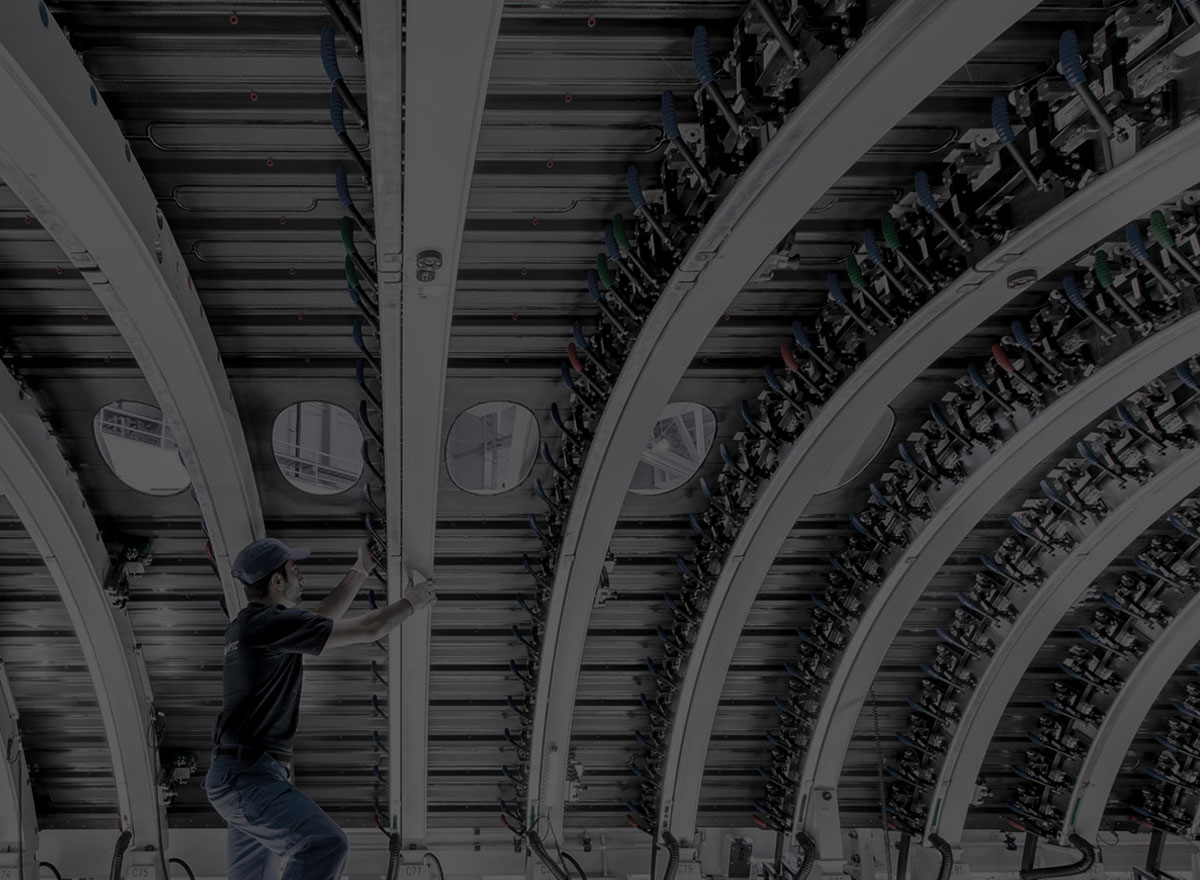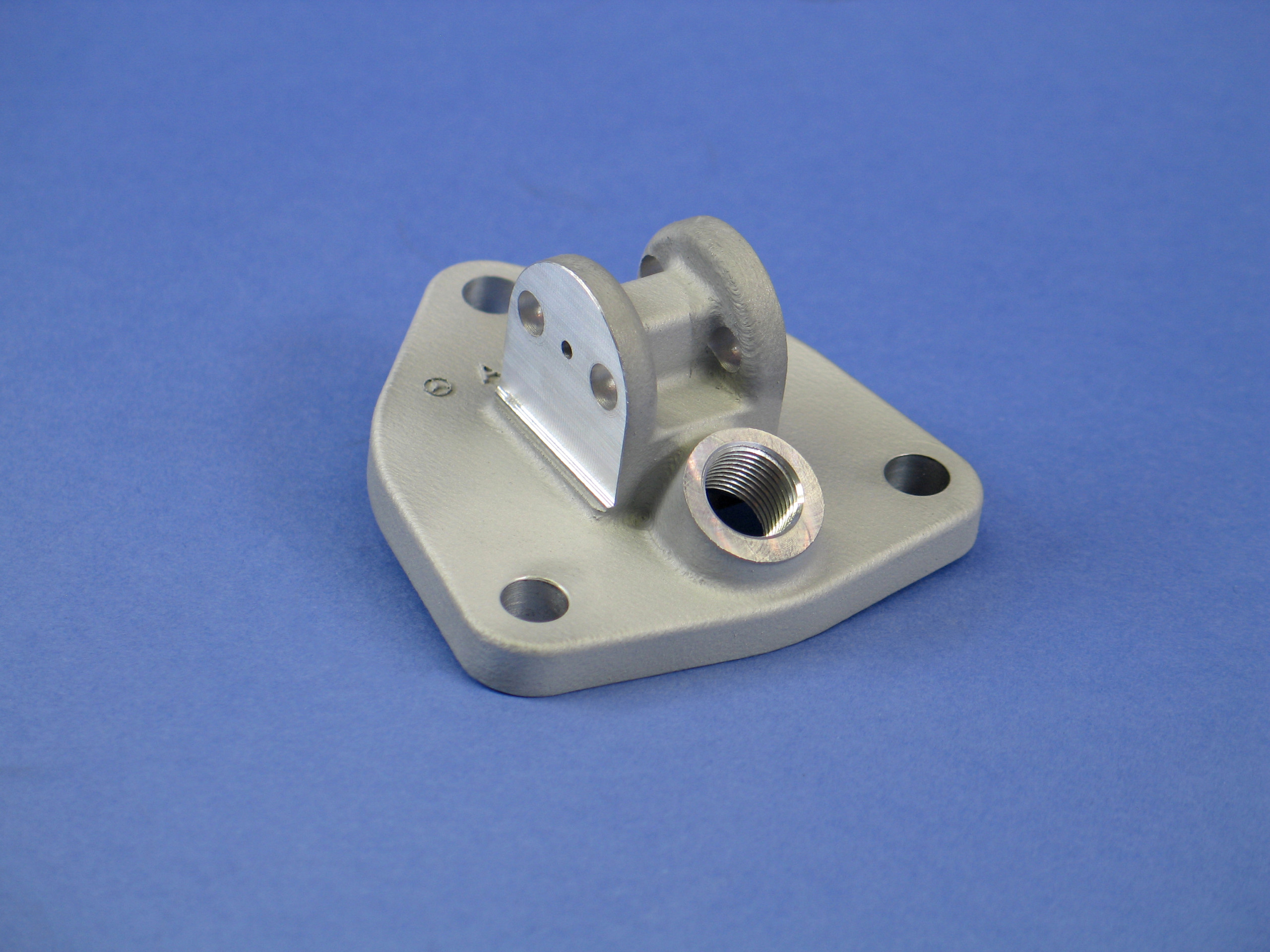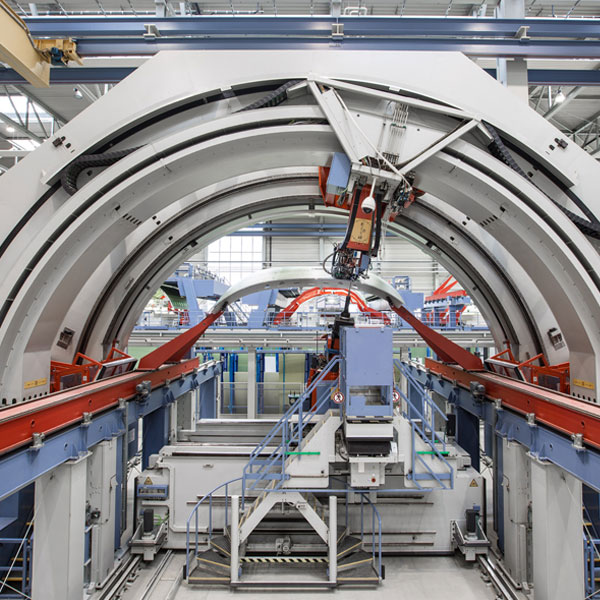NextGenAM – pilot project for automated metallic 3D printing proves a complete success
What began as a promising vision in May 2017 has now reached a successful conclusion: the project "NextGenAM" will work on the development of a pilot production line for a next-generation automated "Additive Manufacturing" process for partners Premium AEROTEC, EOS and Daimler.
- Joint project between Premium AEROTEC, EOS and Daimler demonstrates huge potential for the production of replacement parts and series-production components
- Production of truck parts begun. Potential for further components for conventional and electric cars is being assessed.
- Cost of manufacturing parts could be reduced by up to 50 percent
- Industry 4.0 in Varel: fully automated production process and continuous data string, managed from a control station
- Integrated, scalable process chain covers all steps from data preparation to quality assurance
The 3D printing process, also known as "Additive Manufacturing" (AM), has become more and more interesting as a complementary or alternative process to conventional manufacturing techniques. The technology is described as "additive" because of the way in which the process involves the application of layer after layer of thin material, which is then hardened by an energy source. Along with plastics and ceramics, it is also possible to produce metal components in a 3D printing process.
The aim of the pilot project was to develop a digitalised next-generation manufacturing line which would be able to produce aluminium components for the automotive and aerospace sectors significantly more cost-effectively than is currently possible. The successful outcome of NextGenAM: in terms of the overall production process at Premium AEROTEC, manufacturing costs could be reduced by up to 50 percent compared with existing 3D printing systems.
"As far as the aircraft industry is concerned, Premium AEROTEC is today already an international pioneer in the field of metallic 3D printing. The aim now is to build further on this expertise and to bring it to bear in other sectors as well," said Dr Thomas Ehm, Chairman of the Executive Board of Premium AEROTEC. "The successful conclusion of NextGenAM thus represents another important building block in our strategy."
Fully automated production
The secret lies in an ingenious and scalable additive production chain, which is fully automated right through to the point where the printed parts are mechanically sawn off the build platform. This means that no manual work is now required at any stage of the process, from the data preparation and central powder supply through to the AM build process itself and including heat treatment, quality assurance and separation of the components from the build platform. The technical heart of the system is the EOS M 400-4 four-laser system for industrial 3D printing using metal materials. A driverless transport system and robots ensure the smooth movement of the parts through every stage of the production line.
The entire production process runs itself, without operating personnel, from a central, autonomous control station. Fundamental to the system is the way all the machines used are networked. The order data are transmitted to the control station, which then prioritises the various build requests and allocates them to an AM system. During the build process, the manufacturing status can also be retrieved on a mobile device, independent of location. Once the full production chain has been completed, the quality reports are sent back centrally to the control station. All the data necessary for the production of a digital "twin" can be accessed here, so allowing complete traceability, amongst other things.
Dr Adrian Keppler, CEO of EOS, says: "We are very proud of what we have been able to achieve in collaboration with our partners Premium AEROTEC and Daimler. The NextGenAM project has provided a very tangible demonstration of how industrial 3D printing can be used cost-effectively in series production as part of an automated process chain. In combination with the possibilities for digitalisation as used here, the pilot plant represents nothing less than a milestone along the way to digital manufacturing."
Capacity can be extended
A continuous 3D data string with integrated quality management makes this production system one of the first examples of the benchmark for the future, Industry 4.0. The manufacturing process is completely scalable: the production lines can simply be duplicated to extend the capacity of the plant. This brings the promise of further substantial savings in the future as the numbers rise. Today, the pilot facility is already capable of the automated manufacturing of components to series-production quality standards.
Parts for Daimler are already being produced on the new technology line at Premium AEROTEC: the truck unit, for example, is already using the first replacement part manufactured at Premium AEROTEC. This is a bracket for a truck diesel engine.
Replacement parts for trucks and buses
The 3D printing process is particularly useful in the replacement part sector since, in the event of a tool problem, infrequently required parts can often be reproduced more cost-effectively than with conventional sand or pressure casting processes. The first requests for 3D-printed replacement bus parts in aluminium are currently being examined at the Centre of Competence for 3D printing at Daimler Buses. The analysis team in the passenger car area is also currently considering suitable potential applications.
Opportunities for smallest series and advance development
“Additive Manufacturing is also suitable for smallest-series production of new vehicles (limited editions). Systematic development of the parts specifically for 3D printing means that the production costs can be further reduced and the quality optimised", according to Jasmin Eichler, Head of Future Technologies at Daimler AG. "3D printing also makes particular sense during the advance development of vehicles. The low numbers required can often be produced more cost-effectively, and faster, with Additive Manufacturing than with conventional production processes.”
And this applies just as much for vehicles with a combustion engine as for electric cars. 3D printing is also eminently suitable, for instance, for the production of the integrated base plates that carry the cooling lines for the batteries in electric vehicles.
High product quality as standard
High product quality comes as standard in the pilot facility: there is also provision for the use of a high-strength aluminium/magnesium/scandium alloy (also known as Scalmalloy®) for parts used in the aviation and aerospace sectors.
For the automotive sector a classic aluminium alloy (AlSi10Mg) is used, the material properties of which have been continually improved over the course of the pilot project. The material strength and finish quality, amongst other factors, have been significantly improved compared with two years ago when the cooperation started.
Outlook: 3D printing as a production method with good prospects
Now that all the quality checks so far have been passed with such promising results, preparations are under way for an audit according to the requirements of the stringent industry standard VDA 6.3. This is one of the prerequisites at Daimler for the supply of series-production components by contract printing suppliers. The automation of the entire AM production chain will in future make it possible to manufacture larger batches in series production – with the same reliability, functionality, durability and economic efficiency as conventionally manufactured components. Components for new vehicles can be optimised for 3D printing during the design phase, bringing the promise of further advantages in terms of cost. 3D printing also delivers weight benefits, which are of particular interest for electric vehicles. When it comes to replacement parts, 3D brings the advantage, going forward, of saving warehousing costs – because parts can instead be produced "on demand". This vision for the future is also known at Daimler as "Digital Stock", in other words the centralised availability of digital manufacturing data to allow the decentralised production of replacement parts using 3D printing.
As you can see, 3D printing is well on the way to becoming further established within the automotive and aerospace sectors as an additional, very versatile and comparatively young production method.
Project partners
Premium AEROTEC is the first component manufacturer in the world to supply 3D- printed components made out of titanium alloys for the series production of Airbus aircraft. The company is a global player in the aviation sector. Its core business is the development and manufacture of aircraft structures made out of metal and carbon fibre composite materials. The company operates sites in Germany in Augsburg, Bremen, Hamburg, Nordenham and Varel. Premium AEROTEC took on responsibility here for the complete production process involved in the joint project.
EOS is the leading technology supplier in the industrial 3D printing of metals and plastics. Established in 1989, this independent company is a pioneer and innovator of comprehensive solutions in the additive manufacturing sector. A product portfolio comprising EOS systems, materials and process parameters, gives customers crucial competitive advantages in terms of the quality and long-term economic sustainability of their manufacturing processes. As its part of the joint project, EOS provided the complete 3D printing technology and associated software solutions as well as the control station for linking and managing the production chain.
Daimler contributed its experience in large-scale production to the project. Research and advance development units worked very closely together. Aspects covered here included the sample components, computational robustness and the digitalisation of the component data for the complete production process. The testing of the sample components was likewise something that was covered by car manufacturer, as was the production of a standardised manufacturing specifications book for the 3D printing. Daimler was furthermore responsible for monitoring validation and certification according to the VDA 6.3 standard with respect to series production.
Contacts:
Daimler AG
Silke Kögler, +49 711 17-9 64 79, silke.koegler@daimler.com
Christoph Johannes Sedlmayr, +49 711 17-9 14 04, christoph.sedlmayr (at) daimler.com
EOS GmbH Electro Optical Systems
Martin Grebner, +49 89 893 36 2264, martin.grebner (at) eos.info
Premium AEROTEC
Barbara Sagel, +49 821 801 63770, barbara.sagel (at) premium-aerotec.com
Further information about Daimler is available online:
www.media.daimler.com and www.daimler.com
This document contains forward-looking statements that reflect our current assessment of future events. Words such as 'anticipate', 'assume', 'believe', 'estimate', 'expect', 'intend', 'may/might', plan', 'project', 'are likely to' and similar expressions are used to identify such forward-looking statements. Such statements are subject to many risks and uncertainties. Examples include an adverse change in the global economic situation, in particular a decline in demand in our key sales markets, a worsening of the sovereign-debt crisis in the euro zone, an intensification of the budgetary situation in the USA, a deterioration in our funding opportunities in the credit and financial markets; events of force majeure including natural disasters, acts of terrorism, political unrest, industrial accidents and their effects on our sales, purchasing, production or financial services activities, changes in currency exchange rates; a shift in consumer preference towards smaller, lower margin vehicles, a possible lack of acceptance of our products or services which limits our ability to achieve prices as well as to adequately utilise our production capacities; price increases in fuel or raw materials; disruption of production due to shortages of materials, labour
strikes or supplier insolvencies, a decline in resale prices of used vehicles, the effective implementation of cost-reduction and efficiency-optimisation measures; the business outlook of companies in which we hold a significant equity interest; the successful implementation of strategic cooperations and joint ventures; changes in laws, regulations and government policies, particularly those relating to vehicle emissions, fuel economy and safety; the conclusion of pending governmental investigations and the outcome of pending or threatened future legal proceedings and other risks and uncertainties, some of which we describe under the heading 'Risk Report' in the most recent Daimler Annual Report. If any of these risks and uncertainties materialise, or if the assumptions underlying any of our forward-looking statements prove incorrect, then our actual results may be materially different from those we express or imply by such statements. We do not intend or assume any obligation to update these forward-looking statements. Any forward-looking statement speaks only as of the date on which it is made.
Daimler at a glance
Daimler AG is one of the world's most successful automotive companies. With its divisions Mercedes-Benz Cars, Daimler Trucks, Mercedes-Benz Vans, Daimler Buses and Daimler Financial Services, the Daimler Group is one of the biggest producers of premium cars and the world's largest producer of trucks above 6 tons. Daimler Financial Services provides financing, leasing, fleet management, investment products and brokerage of credit cards and insurance, as well as innovative mobility services. The company founders, Gottlieb Daimler and Carl Benz, made history by inventing the automobile in 1886.
As a pioneer of automotive engineering, Daimler sees shaping the future of mobility in a safe and sustainable way as both motivation and obligation. The company's focus therefore remains on innovative and green technologies as well as on safe and superior vehicles that both captivate and inspire. Daimler continues to invest systematically in the development of efficient powertrains – from high-tech combustion engines and hybrid vehicles to all-electric powertrains with battery or fuel cell – with the goal of making locally emission-free driving possible in the long term. The company's efforts are also focused on the intelligent connectivity of its vehicles, autonomous driving and new mobility concepts. This is just one example of how Daimler willingly accepts the challenge of meeting its responsibility towards society and the environment. Daimler sells its vehicles and services in nearly every country of the world and has production facilities in Europe, North and South America, Asia and Africa. In addition to Mercedes-Benz, the world's most valuable premium automotive brand (source: Interbrand Study, 10/4/2018), as well as Mercedes-AMG, Mercedes-Maybach and Mercedes me, the brands smart, EQ, Freightliner, Western Star, BharatBenz, FUSO, Setra and Thomas Built Buses, and Daimler Financial Services' brands: Mercedes-Benz Bank, Mercedes-Benz Financial Services and Daimler Truck Financial. The company is listed on the Frankfurt and Stuttgart stock exchanges (ticker symbol DAI). In 2018, the Group sold 3.4 million vehicles and employed a workforce of around 298,700 people. Revenues totalled
167.4 billion euros and EBIT stood at 11.1 billion euros.
About EOS
EOS is the world's leading technology supplier in the field of industrial 3D printing in metal and plastic. Established in 1989, this independent company is a pioneer and innovator of comprehensive solutions in the additive manufacturing sector. Its product portfolio, comprising EOS systems, materials and process parameters, gives customers crucial competitive advantages in terms of the quality and long-term economic sustainability of their manufacturing processes. This portfolio is complemented by a global service network and a comprehensive range of consulting services.
About Premium AEROTEC
Premium AEROTEC is a global player in the aviation sector and generated revenues of 2 billion euros in 2018. Its core business lies in the development and production of aircraft structures made out of metal and carbon fibre composite materials. The company has sites in Augsburg, Bremen, Hamburg, Nordenham and Varel in Germany, and in Braşov, Romania. Premium AEROTEC currently employs a workforce of approximately 10,000. Further information at www.premium-aerotec.com.
The photo shows an additively manufactured bracket that has been produced on the new technology line at Premium AEROTEC. This part is already used as replacement part in truck diesel motors. (Copyright: Daimler AG)



